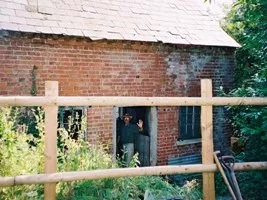Best viewed in landscape
Shelsley Water Mill
The Restoration Story So Far
Where to start? There was a water mill at Shelsley Walsh in 1308, but we have no idea of what it looked like or even if it was on the same site.
We could start with the formation of the Society that aims to bring the mill back into use, but the real beginning of our story is a hundred years earlier. The summer of 1905, to be less vague.
The owner of Court House Farm, including the mill, was Montagu C. H. Taylor Esq. Mr. Taylor was enthusiastic about new technology and was a member of the Midland Automobile Club, a motoring organisation that organised social and competitive events.
Hillclimbs were a very popular form of motorsport in those early days of motoring and competitive hillclimbs had been held on public roads. The MAC had organised one event on private roads but that venue proved to be unavailable for further events. Montagu Taylor offered the use of a farm track at Shelsley Walsh and on the 12th. August 1905 the first hillclimb event was held on what is now the oldest motor sport track in the world.
Montagu Taylor granted the MAC a 99 year lease on the hill and that lease came up for renewal in 2005. The new lease that ensures that hillclimbing will continue at this historic venue includes many more of the farm buildings than used to be the case. The extra buildings now in the control of the MAC included the water mill.
Most of the farm buildings could be put to good use by the MAC, as offices and other facilities for the hillclimb competitors and spectators, but the mill had no clear use. There was even a suggestion that the mill should be demolished, to save on future maintenance costs.
It was at this point that one of the members of the MAC suggested that the mill should be repaired and made an attraction in its own right. Martyn Herridge soon gathered support from other members, notably Colin and Drene Baker.

The majority of the MAC members and a considerable number of local residents didn't know that there was a watermill at Shelsley Walsh, so opening up the building to view was essential to attract helpers.
One of the first tasks was to clear enough weeds and foliage to expose the mill to view.
One of the first volunteers to come along to a working day was John Dyas who made the mistake of admitting that he had done "a bit of bricklaying". In the coming months John was going to do rather more than a bit of bricklaying.
A meeting was called for all MAC members with an interest in bringing the mill back to life and the core of what would soon become the Shelsley Water Mill Society was formed. Jim Weston would become Treasurer with the support of wife Susan. Richard and Margaret Gallé joined the team and Adam Cooper pledged support when work commitments allowed.
By August 2006 a routine had been established of working on Tuesdays and Thursdays each week. This suited the majority of the team who are retired but does mean that younger supporters like Adam can only help now and again when work allows. Three more volunteers joined the team in September, Max Hunt and David Lowe at the beginning of the month and John North later. Headley Fletcher and Derek Ainscow added their efforts the following month.
So what can eight gentlemen of pensionable age achieve? With the support of their partners, of course.
Early efforts concentrated on clearing the site and making sure that the building was safe. Very early in the proceedings we borrowed acroprops from local builder John Stinton to shore up the floor in the mill. Damp penetrating the brickwork had rotted off the ends of the floor joists and prompt action was needed. Mostly, however, we left the interior of the mill alone at that stage, and set our sites on getting the waterwheel going.
Before we had any chance of getting the wheel to turn under water power we had to have some way of letting the water get away. The channel that takes water away from the waterwheel is called the tailrace and Shelsley Water Mill didn't have one anymore.
Our first challenge, then, was restoring the tailrace (click to read the next chapter in the restoration story) because if we couldn't do that we might as well give up
Read the regular diary entries
We need your support. Click here to see how you can help
Leave the Water Mill Restoration Story and return Home